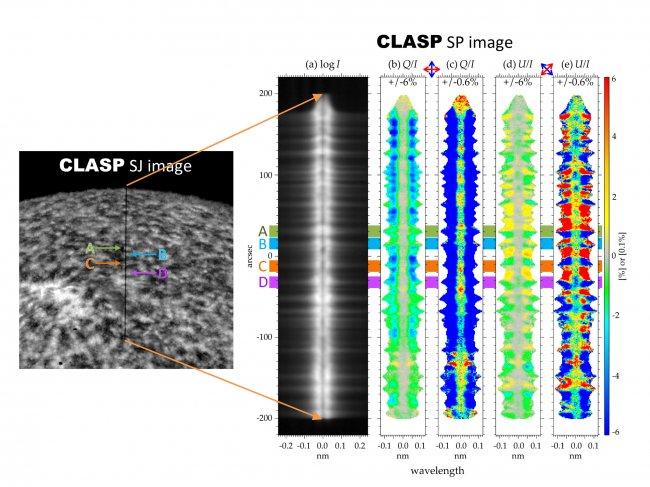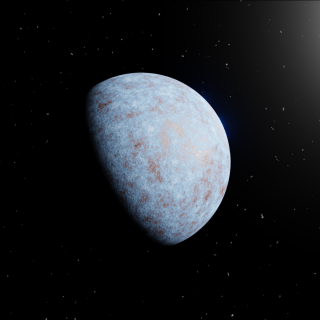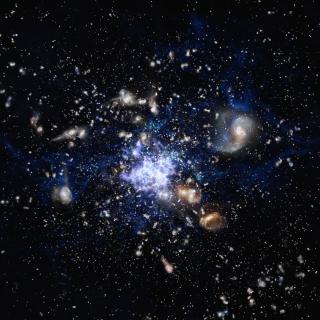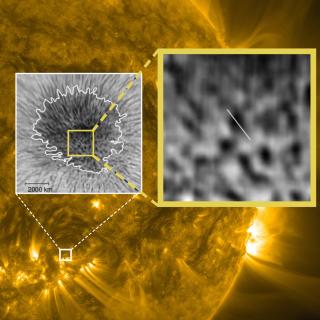CAPTION: Observations obtained with CLASP of the intensity and polarization in the hydrogenLyman-alpha line of the solar radiation at 1216 Angstroms. LEFT PANEL: image of the region of the Sun observed by CLASP (1 arcsec corresponds to 725 km on the solar disk). The black line indicates the position of the slit of the spectro-polarimeter. RIGHT PANELS: for each point along this slit, the figure shows the wavelength variation of the intensity I (left panel) and of the fractional linear polarization Q/I (second and third panels) and U/I (panels fourth and fifth). The Stokes I parameter quantifies the intensity of the radiation for each wavelength, while the Stokes parameters Q and U quantify the linear polarization. See Kano, Trujillo Bueno, Winebarger et al. (2017; ApJ, 839, L10).
The CLASP instrument (Chromospheric Lyman-Alpha SpectroPolarimeter), launched on 3 September 2015 by a NASA suborbital rocket, measured for the first time the polarization of the solar ultraviolet radiation in the hydrogen Lyman-alpha line and in the Si III resonance line at 1206 Angstroms. The instrument carried out observations above a height of 150 km, where ultraviolet radiation begins to be measurable, while moving up to a height of 300 km following a parabolic trajectory (see video below). The four research centers responsible for this mission (NAOJ, NASA/MSFC, IAS, IAC) announce today the first results published in The Astrophysical Journal.
The importance of this international experiment, motivated by theoretical investigations carried out at the Instituto de Astrofísica de Canarias (IAC), is that it opens a new window for the exploration of the magnetic field and the geometry of the plasma in the transition region between the chromosphere and corona of the Sun. Little is known about the physical mechanisms that dominate the behavior of this enigmatic region of the solar atmosphere where, in just 100 km, the temperature increases from ten thousand degrees in the chromosphere to more than one million degrees in the corona. The key player is the magnetic field. Therefore, CLASP observes the polarization in lines of the ultraviolet spectrum, sensitive via the Hanle effect to the presence of magnetic fields in the base of the solar corona. The Hanle effect consists in the modification, due to the action of a magnetic field, of the linear polarization produced by scattering processes (absorption and re-emission of photons) in a spectral line.
"While the polarization of the Lyman-alpha line is sensitive to magnetic fields with strengths between 10 and 100 gauss –explains Javier Trujillo Bueno, CSIC Research Professor at the IAC and one of the four principal investigators of the CLASP project–, the Si III line is sensitive to stronger magnetic fields. The simultaneous measurement of the polarization in two spectral lines with different sensitivity can help us to determine with more precision the magnetic field in the outer regions of the solar atmosphere (chromosphere, transition region and corona)”.
In addition, it is in such regions of the solar atmosphere where explosive phenomena occur that can seriously affect the Earth's magnetosphere, the shield that protects us from the energetic particles of the solar wind. "This is why it is extremely important –says Andrés Asensio Ramos, another of the IAC scientists involved in the CLASP project– to develop new techniques for determining the magnetic field of the plasma in the upper chromosphere and corona of the Sun."
Ultraviolet Spectropolarimetry
Having measured the predicted polarization for the first time, this experiment is a milestone in Solar Physics. CLASP has opened a new research window in astrophysics: ultraviolet spectropolarimetry.
This experiment "has confirmed the results of the theoretical research that motivated its development," says Luca Belluzzi, another member of the CLASP project that is now working at the Istituto Ricerche Solari Locarno (IRSOL, Switzerland). For example, the significant polarization signals observed in the wings of the Lyman-alpha line show the important impact of the quantum-mechanical interference between the two excited atomic levels of such spectral line (effects that cannot be easily observed in terrestrial laboratories).
On the other hand, CLASP has shown a surprise of great scientific interest. “At the center of the Lyman-alpha line, where the Hanle effect operates, the spatial variation of the observed linear polarization cannot be explained with today’s three-dimensional models of the solar chromosphere”, explains Jiri Stepan, a researcher from the Academy of Sciences of the Czech Republic who is currently on sabbatical stay at the IAC within the framework of the visiting researchers program of the Jesús Serra Foundation and the Severo Ochoa program. "This fact suggests that its thermal and magnetic structure is much more complex," says this scientist who is also a member of the CLASP project.
With the help of supercomputers, such as the MareNostrum of the National Supercomputing Center in Barcelona, the CLASP researchers are deciphering the magnetism and geometry of the chromosphere-corona transition region. Furthermore, within the framework of the ERC Advanced Grant, a prestigious grant from the European Research Council recently awarded to Javier Trujillo Bueno, the team will carry out new research activities. These will be important for the second flight of CLASP accepted by NASA, which in 2019 will observe the resonance lines of ionized magnesium, as well as for interpreting the extraordinary spectropolarimetric observations that will be obtained with the next generation of ground-based and space telescopes.
More information in the articles published in "The Astrophysical Journal":
(1) Kano, R., Trujillo Bueno, J., Winebarger, A. et al. 2017, "Discovery of Scattering Polarization in the Hydrogen Lyman-alpha Line of the Solar Disk Radiation", The Astrophysical Journal Letters, 839, L10
(2) Ishikawa, R., Trujillo Bueno, J., Uitenbroek, H., et al., "Indication of the Hanle Effect by Comparing the Scattering Polarization Observed by CLASP in the Lyman-α and Si III 120.65 nm Lines", The Astrophysical Journal, issue of May 2017
The Principal Investigators of the CLASP project are:
· Amy Winebarger (NASA Marshall Space Flight Center, NASA/MSFC)
· Ryouei Kano (National Astronomical Observatory of Japan, NAOJ)
· Frédéric Auchère (Institut d'Astrophysique Spatiale, IAS)
· Javier Trujillo Bueno (Instituto de Astrofísica de Canarias, IAC)
Related press release:
· CLASP has a successful mission
Contacts at the IAC:
· Javier Trujillo Bueno: jtb [at] iac.es (jtb[at]iac[dot]es)
· Andrés Asensio Ramos: aasensio [at] iac.es (aasensio[at]iac[dot]es)
· Jiri Stepan: jiri.stepan [at] asu.cas.cz (jiri[dot]stepan[at]asu[dot]cas[dot]cz)



